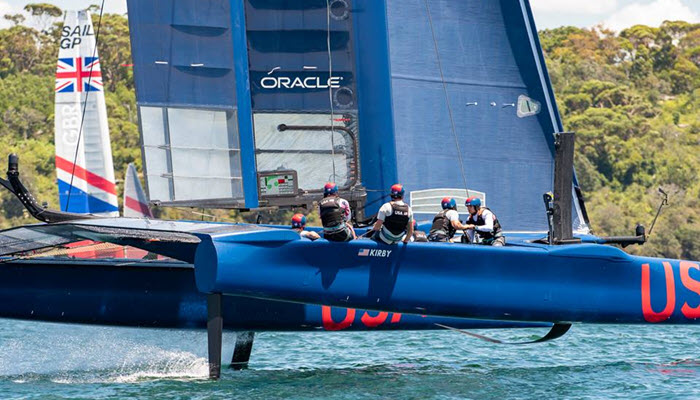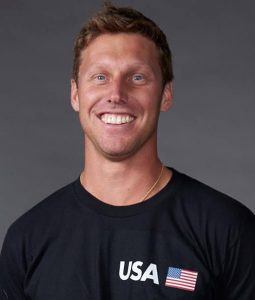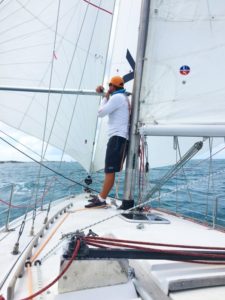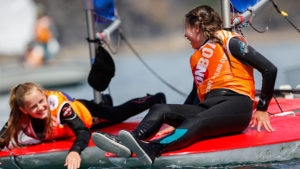Launching SailGP onto the world stage


Rome Kirby
With limited practice time, and no preseason, the first event of the inaugural SailGP season is going to unveil on the world stage the latest attempt to deliver a commercially viable sailing product for spectator consumption.
Funded by billionaire Larry Ellison, and with the 5-stage circuit dangling a USD $1 million purse for the season champion, the six national teams are chomping on the bit for racing to begin February 15-16 in Sydney, Australia.
Among the field will be the United States SailGP Team led by Rome Kirby who sat down with a Scuttlebutt editor to offer an update:
It’s been four months since your team was announced, and now that you have some training time under your belt, how has the foiling wing-powered F50 catamaran impressed you?
For starters, we’d like to have a lot more time on the boat. We’ve probably had about seven days, but it’s quite clear the boats are definitely faster than they were in the 35th America’s Cup. But they’re also harder to sail, not so much physically, but in terms of getting around the race track with all the controls and configurations. It’s pretty impressive what’s now under the hood, and it all translates to speed so they’re going to be cool to watch.
Australia SailGP Team Skipper Tom Slingsby gave a video tour of the control systems. It looked overwhelming.
The America’s Cup rule had a lot of control limitations that have been removed, which has translated to more speed but also more adjustments. Combine that with one less person in the boat than we had for the 2017 racing in Bermuda, it means these boats are definitely a handful to sail. They’re not easy. They are complex and they’re going to take a lot of time to be of mastered.
Your team recently announced the addition of Taylor Canfield, who is also involved in the America’s Cup with Stars + Stripes Team USA.
Taylor’s been with us since our tryouts in August, but we weren’t sure if he was going to be able to do the whole season. Now that he’s been able to make that commitment, we’re super happy to have him involved. He fits into our team really well, so hopefully we can show what we got in Sydney.
How even do you expect the field to be?
With regard to practice time, the league has tried to equalise it as best they can, but at the end of the day, there are certain teams with crew that have done America’s Cups together and have spent plenty of time sailing these types of boats. When it comes down to understanding these boats and how they operate, how you sail them and the communication loop, that kind of time is invaluable. We don’t have that kind of depth on our team, so we’re trying to bridge that gap, particularly as none of us have really sailed together. We’re up against it right now, but the guys are working really hard to get there.
For this first event, where do you expect the differences will be among the teams?
It’ll come down to communication and boat handling. For any team that has that mastered, then it comes down to the team that can stay out of trouble and keep it simple. The top teams will be those that can sail the boat clean and not make that many mistakes, but my hunch is we’re going to see a lot of teams make plenty of mistakes in this first event. But we can’t wait for that first race. To see the fleet making the turn around that first race mark, it’ll be pretty impressive. It’ll be fun to watch.
With regard to boat handling, have the teams mastered the basics like foiling jibes and foiling tacks?
With all due respect, I find it kind of funny that you say “mastering the basics” because none of that is basic on these boats. All of us are learning how to foil tack and jibe in these boats, because it’s totally different systems and totally different timings, and the boats are so complex that it’s so different from what we sailed in the 35th America’s Cup. The boards are different, the stability of the boats is different, the attitude of the boats is different. There’s nothing basic about anything we do on these boats.
In terms of conflict on the race course, how is judging being handled?
We’ll have two umpire boats on the water, and then umpires in the booth, and it’ll be instant. It’ll be similar to the last America Cup, but to another level. I think they’ve learned a lot, and I think you’ll see massive improvements in that.
Anything about Sydney Harbour that keeps you up at night?
With these boats going so fast, we don’t have much space to get around the race track, that’s for sure. It’s pretty tight.
How insane is this event going to be?
SailGP has definitely turned a sailboat regatta into an extreme sport. We’re definitely pushing the limits, for sure. Having six boats going that fast around a tight race track, with so much power, it’s hard to explain until you actually go do it.
I’m sure there’ll be plenty of armchair quarterbacking with criticism, but I can’t understate how these boats are not easy to sail. But it’s also going to be pretty fun to watch, on a small race track, with these boats going that fast.
The other day, it was blowing probably 10 knots, and we were all doing 25 to 30 knots. That’s pretty insane…
ABOUT SAILGP
Established in 2018 and headquartered in London and San Francisco, SailGP seeks to be an annual, global sports league featuring fan-centric, inshore racing in some of the iconic harbours around the globe, and culminates with a USD $1 million winner-takes-all match race. Rival national teams from Australia, China, France, Great Britain, Japan, and the United States battle it out in identical wing-powered, foiling F50 catamarans, engineered to exceed 50 knots.
2019 Schedule
Sydney, Australia (February 15-16)
San Francisco, USA (May 4-5)
New York, USA (June 21-22)
Cowes, UK (August 10-11)
Marseille, France (September 20-22)
Story by Scuttlebutt Sailing News










